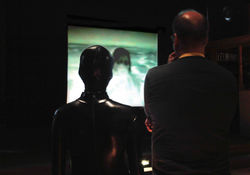RED BIND - Gilivanka KEDZIOR & Barbara FRIEDMAN
 |  |  |  | ![Melanie Boisvert [ RED BIND ] - [ ACANTHESTHESIA #2 ]](https://static.wixstatic.com/media/ce90ac_9511bf712ea44f008dd66069943bae38.jpg/v1/fill/w_250,h_183,al_c,q_90,enc_auto/ce90ac_9511bf712ea44f008dd66069943bae38.jpg) |
|---|---|---|---|---|
![Melanie Boisvert [ RED BIND ] - [ ACANTHESTHESIA #2 ] (2)](https://static.wixstatic.com/media/ce90ac_a92e547d355f41b794144eb1f6d74407.jpg/v1/fill/w_250,h_146,al_c,q_90,enc_auto/ce90ac_a92e547d355f41b794144eb1f6d74407.jpg) |  |
ACANTHESTHESIA
Interactive video-performance | 2010 | 10’ to 20’
JULY 2012 | 22nd International Week of young Theatre ARENA... of the young Arts, Kulturforum Logenhaus, Erlangen, Germany | Winners of the Co-Production Award
MAY 2012 | MPA-B 2012 Month of Performance Art-Berlin, ACUD Kunstverein/Serendipity Gallery, Berlin, Germany | Curator : Jörn J. BURMESTER
Photos | Melanie BOISVERT, Carmen LOCH & Jörn J. BURMESTER
Acanthesthesia :
From Ancient Greek ἄκανθα (ákantha, “thorn”) + αἴσθησις (aísthēsis, “sensation”).
Noun (uncountable) : A type of paresthesia characterized by a tingling, numbing sensation as of being pierced by needles, usually caused by the (temporary) clamping of nerves.
Covered from head to toe in black zentaï suits, our mouths are hidden by a large oblong of red duct tape. Only our eyes - very heavily made-up to make them over-conspicuous -, can be distinguished.
We move very slowly towards the public, with an economy of gestures and movements that makes us look like two puppets. We wander among the audience and begin our interaction when the emotion aroused by the video/soundtrack begins to emerge.
This emotion is a subjective datum, which we feel growing within ourselves, or which becomes tangible on the faces of the audience.
Each of us, independently of the other, chooses her own modus operandi of approach and stares at the face of a spectator who will then seem moved or touched, or yet, impassible.
Eye to eye, we endeavor to collect the emotions emerging on the faces of the watchers. We look at those who look, watching our faces. We try to read their emotions, in their immediacy.
We modify their expressions by the mere act of our presence and the intensity of our gaze. We do not touch them physically, we address them no accusatory glance. Our eye wants to be documentary and, at times, possibly empathetic.
This scenario runs in a random way, depending on the emotional encounters.
Acanthesthésie :
- acantho : du grec akantha, [acanth(o)-] épine ; préfixe ou racine exprimant une forme en épine ou une sensation de piqûre ;
- esthésio, esthésie : du grec aisthêsis [esthésio, esthésie], sensation, perception.
Nom féminin : Une personne souffrant d'acanthesthésie a une sensation de piqûres, sans qu'il y ait stimulation.
Nous sommes intégralement revêtues de combinaisons en zentaï noir. Notre bouche est masquée par un grand rectangle de chatterton rouge. Seuls nos yeux sont discernables, sur-maquillés afin de les rendre ostensibles.
Nous nous avançons très lentement vers le public, dans une économie de gestes et de mouvements qui nous fait ressembler à deux pantins. Nous déambulons au milieu des spectateurs et commençons notre interaction au moment où l'émotion suscitée par la vidéo/bande sonore commence à poindre.
Cette émotion est une donnée subjective, que nous sentons monter en nous-mêmes ou qui devient palpable sur le visage des spectateurs.
Chacune, indépendamment de l'autre, choisit son propre mode opératoire d'approche et fixe le visage d'un spectateur, suivant qu'il lui semble ému ou au contraire impassible.
Les yeux plantés dans leurs yeux, nous cherchons à recueillir les émotions naissantes sur le visage des regardants. Nous regardons ces regardants, qui regardent nos visages. Nous lisons leurs émotions, dans l'immédiateté.
Nous modifions leurs expressions du fait de notre seule présence et de notre regard appuyé. Nous ne les touchons pas physiquement, nous ne posons sur eux aucun regard accusateur. Notre œil se veut documentaire, parfois éventuellement empathique.
Le scénario se déroule de manière aléatoire, au gré des rencontres affectives.




